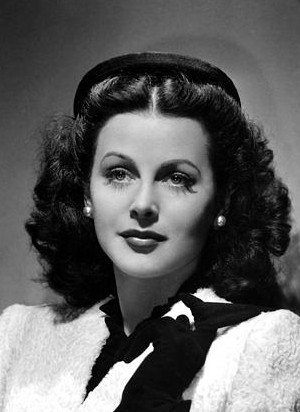-
(b.) -1914 November 09(d.)2000
Bio/Description
An Austrian actress and inventor, she was born in Vienna, Austria-Hungary. Her most significant technological contribution was her co-invention, together with composer George Antheil, of an early technique for spread spectrum communications and frequency hopping, which paved the way for today's wireless communications and which, upon its invention in 1941, was deemed so vital to national defense that government officials would not allow publication of its details. At the Electronic Frontier Foundation's Sixth Pioneer Awards in 1997, she and George Antheil were honored with special awards for their "trail-blazing development of a technology that has become a key component of wireless data systems". Composer George Antheil, a neighbor of hers in California, who was a son of German immigrants had experimented with automated control of musical instruments, including his music for Ballet M?canique, originally written for Fernand L?ger's 1924 abstract film. This score involved multiple player pianos playing simultaneously. During World War II, she and Antheil discussed the fact that radio-controlled torpedoes, while important in the naval war, could easily be jammed by broadcasting interference at the frequency of the control signal, causing the torpedo to go off course. In 1933 she had married a husband 14 years her senior, Austrian ?Cartridge King? Fritz Mandl who was Director General of weapons manufacturer, Hirtenberger Patronenfabrik. That first year, Mandl was embroiled in a notorious illegal arms transport scandal, the ?Hirtenberger Waffenaffaire,? in which his company smuggled German and Austrian weapons out of the country under Swiss labels. The company made shells and grenades as well as aircraft from the mid- 1930s on and supplied arms for Mussolini?s 1935 invasion of Africa. Mandl was also interested in control systems. He frequently entertained key buyers and sellers of arms ? as well as Hitler and Mussolini themselves ? during the runup to World War II. She, in her role as hostess at these gatherings was provided a link to discussions of weapons technology and, most likely, radio-controlled torpedoes and the need for an anti-jamming device. Within four years of her unhappy marriage, she had escaped her domineering husband and sailed to the United States, where she eventually became a citizen in 1953. Having learned what she did about torpedoes from Mandl, she and Antheil developed the idea of using frequency hopping to avoid jamming: using a piano roll to unpredictably change the signal sent between a control center and the torpedo at short bursts within a range of 88 frequencies in the radio-frequency spectrum (there are 88 black and white keys on a piano keyboard). The specific code for the sequence of frequencies would be held identically by the controlling ship and in the torpedo. It would be practically impossible for the enemy to scan and jam all 88 frequencies, as this would require too much power or complexity. The frequency-hopping sequence was controlled by a player-piano mechanism, which Antheil had earlier used to score his Ballet Mecanique. On August 11, 1942, U.S. Patent 2,292,387 was granted to Antheil and to her under her married name at the time (Hedy Kiesler Markey). This early version of frequency hopping, although novel, soon met with opposition from the U.S. Navy and was not adopted. The idea was not implemented in the US until 1962, when it was used by U.S. military ships during a blockade of Cuba after the patent had expired. This work was honored in 1997, when the Electronic Frontier Foundation gave her a belated award for her contributions. In 1998, an Ottawa wireless technology developer, Wi-LAN Inc., acquired a 49% claim to the patent from her for an undisclosed amount of stock per Eliza Schmidkunz of Inside GNSS, September 2006. Their frequency-hopping idea serves as a basis for modern spread-spectrum communication technology, such as Bluetooth, COFDM (used in Wi-Fi network connections), and CDMA which has been employed in wireless technologies such as cell phones.). Blackwell, Martin, and Vernam's 1920 patent seems to lay the communications groundwork for their patent, which employed the techniques in the autonomous control of torpedoes. She wanted to join the National Inventors Council but was reportedly told by NIC member Charles F. Kettering and others that she could better help the war effort by using her celebrity status to sell War Bonds. She was a student of theater director Max Reinhardt in Berlin, who called her the "most beautiful woman in Europe" due to her "strikingly dark exotic looks", a sentiment widely shared by her audiences and critics. She began her film career in 1930 in Czech and German films gaining fame after starring in a controversial 1933 film Gustav Machat?'s Ecstasy which was banned in the United States. The resulting notoriety got her called to Hollywood, where she was signed by MGM during its ?Golden Age?. The studio changed her name and put her in a series of exotic adventure epics such as Algiers (1938) and White Cargo (1942). Her biggest success was in Cecil B. DeMille's spectacular Samson and Delilah (1949) as the title temptress, but her career declined from that point as her looks began to fade and a new crop of beauties supplanted her. She left the screen in 1957. The 1970s were a time of increasing seclusion. She was offered several scripts, television commercials, and stage projects, but none piqued her interest. With failing eyesight, she retreated from public life and settled in Miami Beach, Florida in 1981. She died in Casselberry, Florida at age 85 from heart failure.
-
Date of Birth:
1914 November 09 -
Date of Death:
2000 -
Gender:
Female -
Noted For:
Co-inventor, of an early technique for spread spectrum and frequency hopping, paving the way for today's wireless communications -
Category of Achievement:
-
More Info:


